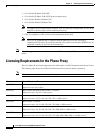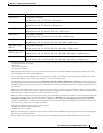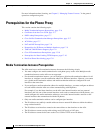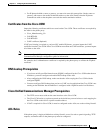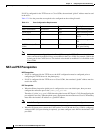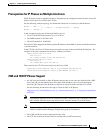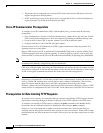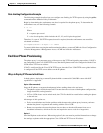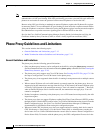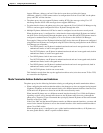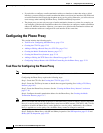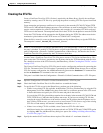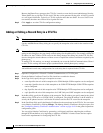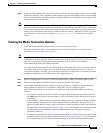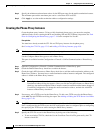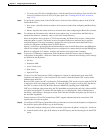
17-12
Cisco ASA Series Firewall ASDM Configuration Guide
Chapter 17 Configuring the Cisco Phone Proxy
Phone Proxy Guidelines and Limitations
Note As an alternative to authenticating remote IP phones through the TLS handshake, you can configure
authentication via LSC provisioning. With LSC provisioning you create a password for each remote IP
phone user and each user enters the password on the remote IP phones to retrieve the LSC.
Because using LSC provisioning to authenticate remote IP phones requires the IP phones first register
in nonsecure mode, Cisco recommends LSC provisioning be done inside the corporate network before
giving the IP phones to end-users. Otherwise, having the IP phones register in nonsecure mode requires
the Administrator to open the nonsecure signaling port for SIP and SCCP on the ASA.
See also the Cisco Unified Communications Manager Security Guide for information on Using the
Certificate Authority Proxy Function (CAPF) to install a locally significant certificate (LSC).
Phone Proxy Guidelines and Limitations
This section includes the following topics:
• General Guidelines and Limitations, page 17-12
• Media Termination Address Guidelines and Limitations, page 17-13
General Guidelines and Limitations
The phone proxy has the following general limitations:
• Only one phone proxy instance can be configured on the ASA by using the phone-proxy command.
See the command reference for information about the phone-proxy command. See also Creating the
Phone Proxy Instance, page 17-18.
• The phone proxy only supports one Cisco UCM cluster. See Creating the CTL File, page 17-15 for
the steps to configure the Cisco UCM cluster for the phone proxy.
• The phone proxy is not supported when the ASA is running in transparent mode or multiple context
mode.
• When a remote IP phone calls an invalid internal or external extension, the phone proxy does not
support playing the annunciator message from the Cisco UCM. Instead, the remote IP phone plays
a fast busy signal instead of the annunciator message "Your call cannot be completed ..." However,
when an internal IP phone dials in invalid extension, the annunciator messages plays "Your call
cannot be completed ..."
• Packets from phones connecting to the phone proxy over a VPN tunnel are not inspected by the ASA
inspection engines.
• The phone proxy does not support IP phones sending Real-Time Control Protocol (RTCP) packets
through the ASA. Disable RTCP packets in the Cisco Unified CM Administration console from the
Phone Configuration page. See your Cisco Unified Communications Manager (CallManager)
documentation for information about setting this configuration option.
• When used with CIPC, the phone proxy does not support end-users resetting their device name in
CIPC (Preferences > Network tab > Use this Device Name field) or Administrators resetting the
device name in Cisco Unified CM Administration console (Device menu > Phone Configuration >
Device Name field). To function with the phone proxy, the CIPC configuration file must be in the



